Due to its countless spectacular waterfalls and thrilling canyon-edge views, along with its ease of accessibility, Johnston Canyon is easily among the top three most popular hikes in Banff National Park. Originally a meandering dirt trail with log bridges, the hike up through Johnston Canyon is now a unique stroll along suspended steel catwalks clinging to the side of the canyon, allowing hikers to look straight down at the rushing water below, and includes a short section where hikers duck through a short tunnel to get up close and personal with the spray of Lower Johnston Canyon Falls on the other side.
Sadly, due to the busloads of idiots who also use this trail, you’ll also be looking down at tossed empty water bottles and Starbucks cups that have been carelessly and/or maliciously thrown into the canyon below. This is especially a problem in spring right after the snow melts, revealing months worth of trash below. Please pack out what you pack in at the absolute minimum. And the trade-off is exactly that – it’s undeniable that Johnston Canyon is a beautiful and easy Banff hike at the top of nearly everyone’s to-do lists, but the problem is that it’s at the top of everyone’s to-do lists. If you’re looking for a quiet peaceful walk in nature away from people, then Johnston Canyon isn’t it. The exception is hiking at dawn, dusk, or during the winter. (Personally I find Johnston Canyon at its most beautiful in the winter anyway.) I started my Johnston Canyon hike early in the morning before the sun rose, and while I had the walk in to myself, I still passed dozens of groups of people beginning their hike as I walked out.
Continue reading this blog post for everything you need to know to experience the Johnston Canyon hike in Banff for yourself, including distance, elevation gain, how to get there, the best time to visit, and lots of photos of my experience.
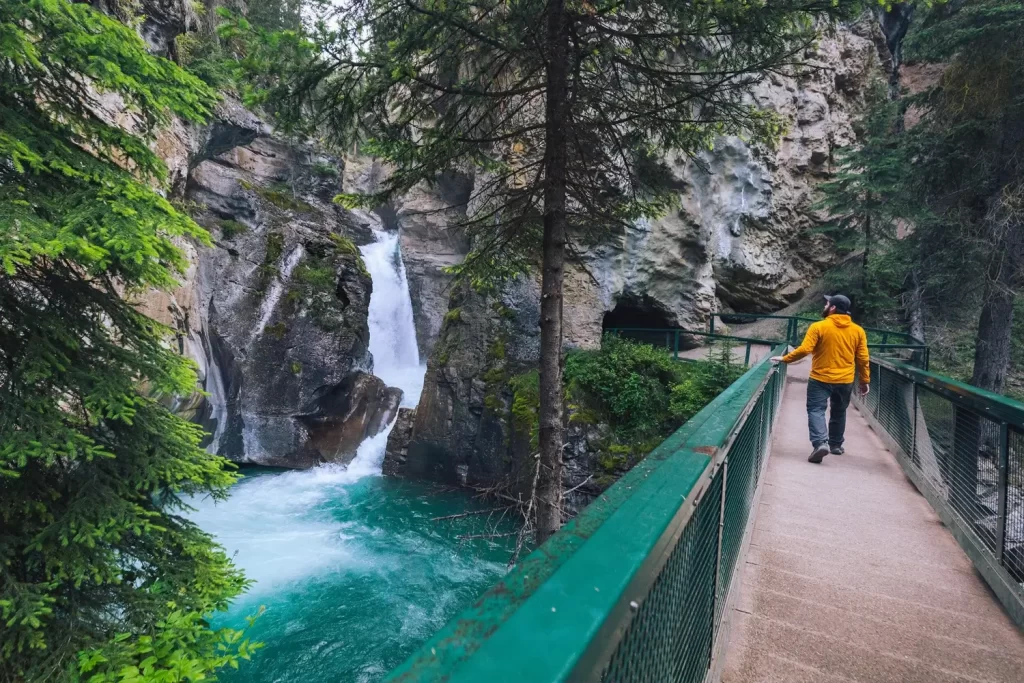
Note: The Johnston Canyon hike is located in Banff National Park, meaning that a valid park pass is required. Day passes can be purchased at the park gates and are per day per person, but if you’re staying a week or longer, it’s more cost-effective to just buy an annual pass instead.
Before visiting Banff National Park it’s essential to read up on the Parks Canada rules that must be followed to avoid tickets and/or fines. When hiking it’s important to avoid harmful practices such as disturbing plants or rock-stacking, or removing any natural object from flowers to rocks, as it’s important to leave the environment as natural as possible for the animals and for fellow hikers to enjoy in perpetuity. As many flowers as there are, there are few enough that if we all took one, then there wouldn’t be any left. If you’re after a souvenir to take home with you, there are tons of gift shops in the Banff townsite to check out. Otherwise take only photos, leave only footprints.
If you haven’t heard of Leave No Trace principles, they’re also really essential to read up on before heading anywhere into the outdoors in general. Following these important principles basically means doing your best to leave beautiful places like Johnston Canyon as good (if not better) than you found them, both for their preservation and for the enjoyment of other visitors.
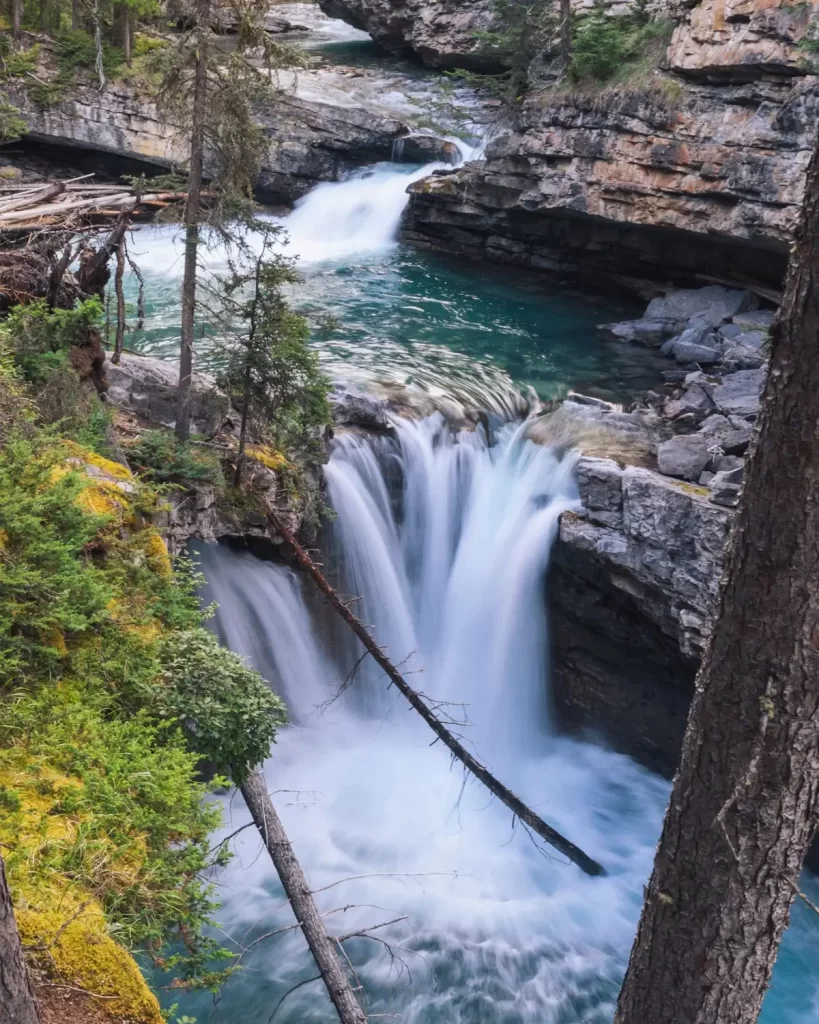
Johnston Canyon Round Trip Details
Distance: 5 KM / 3.1 MI
Elevation Gain: 270 M / 886 FT
Hiking Time: 2-2.5 HRS
Hiking & Safety Tips
- Prepare for the possibility of wildlife encounters. Bear spray is a must whenever travelling in bear country, as well as learning how to use it. Though your chance of an aggressive bear encounter is low, it is always better to be prepared with bear spray. Bear bells are proven to be an ineffective bear deterrent, and are actively discouraged by Parks Canada. The best way to let bears know you’re around is simply to use your voice. Make sure to keep a respectful distance from wildlife and never feed the animals. It may seem kind but it doesn’t just kill wildlife and put people in danger, it’s also illegal.
- Research current trail conditions and make sure you are well-informed about the route before you leave, and assess if it is within your capability. Be aware of what time it gets dark and check the weather forecast. Make sure to tell someone where you’re going and when you expect to return. Every year as more and more people try hiking for the first time, the number of rescues goes up. Being prepared is the best defense.
- Pack everything you need for a successful hike, including enough water and energy-rich snacks. Remember to pack out everything you pack in though – don’t expect to find a convenient garbage can halfway up the trail. Bring appropriate layers (remember you’ll warm up once you start hiking) and sun protection. Hiking poles may be helpful but are not required. In addition to not leaving any garbage on the trail yourself, I highly recommend bringing a garbage bag and collecting any trash that you do see on the trail. You’re guaranteed to make the hike through Johnston Canyon a more enjoyable experience for the next person.
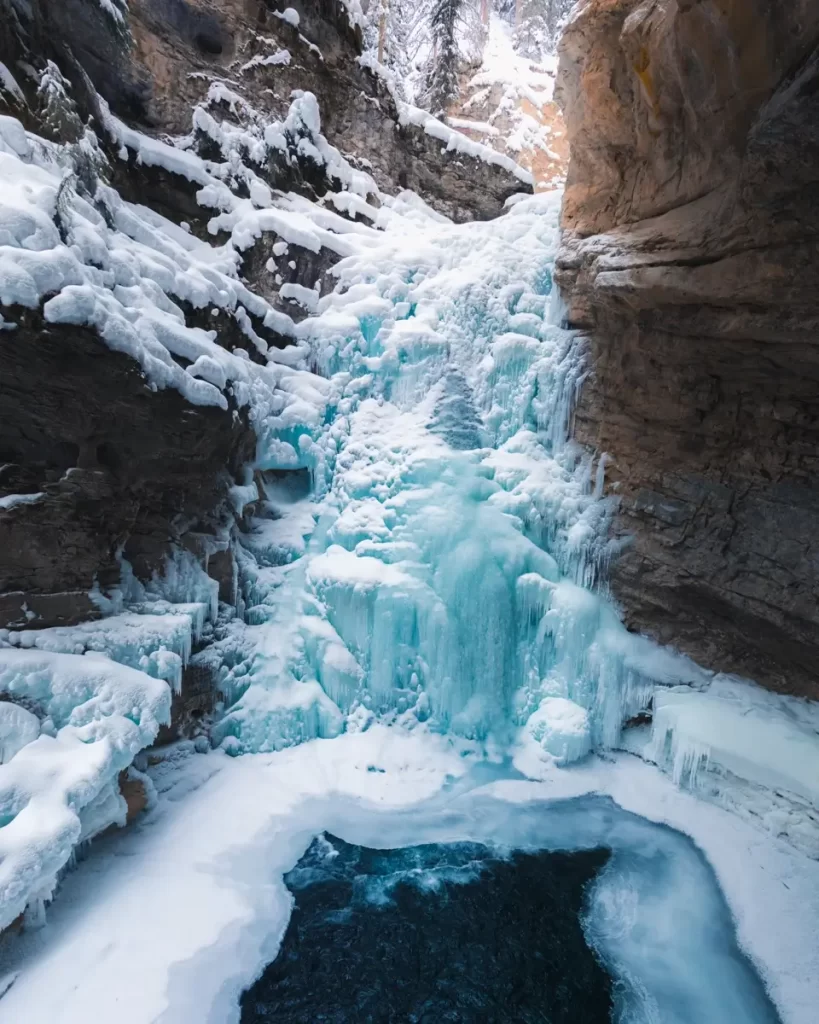
Hiking Johnston Canyon in Winter
As previously mentioned, in my opinion the best time to hike Johnston Canyon is in the winter. The lack of crowds makes it far easier to appreciate the beauty of the canyon without having to line up in order to just see a waterfall (yes, that happens in summer). While many of Banff’s hikes are closed or rarely hiked in the winter, Johnston Canyon is open year-round. For mor information on visiting Johnston Canyon in winter click here.
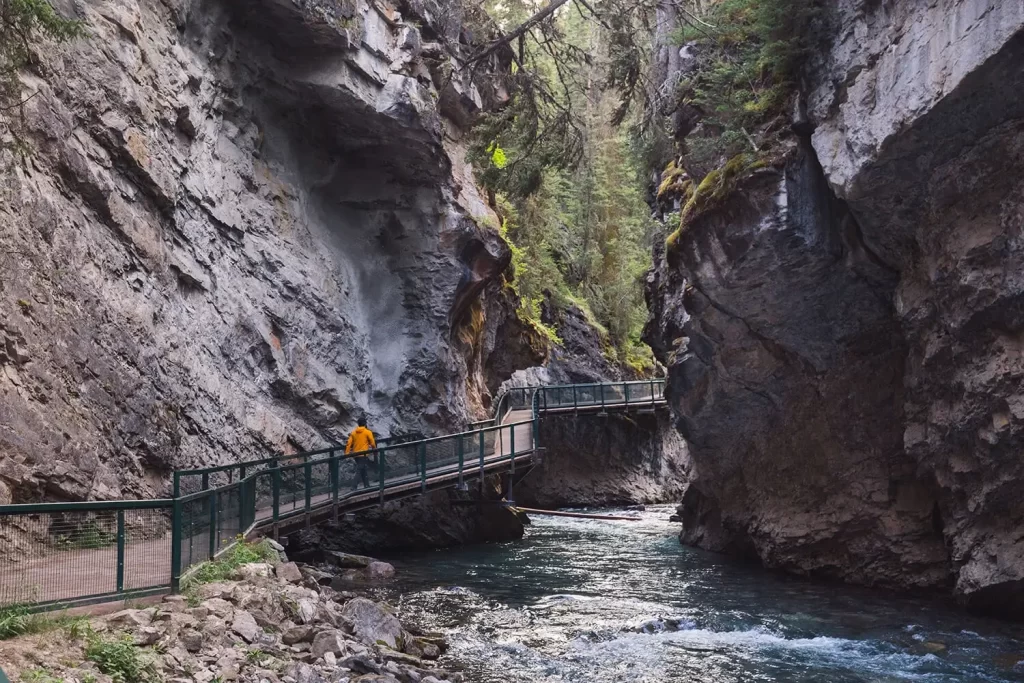
How to Get to Johnston Canyon Trailhead
The Johnston Canyon parking lot is located on the Bow Valley Parkway 23 km north of the town of Banff. It’s possible to drive west from Banff on the Highway 1 for five kilometers before turning north off onto the Bow Valley Parkway and driving up from there. Alternatively it’s possible to just stay on the much faster Highway 1 for the 23km until Castle Junction and turn off onto the Bow Valley Parkway towards Johnston Canyon from there. (Due to closures from May to June and throughout September the latter is the only option.) Doing this also makes it easy to do the short walk to nearby Silverton Falls before or after your Johnston Canyon hike.
The Bow Valley Parkway is described as the “slower and more scenic” alternative to the Highway 1, but frankly I think it’s just slower. Driving on a narrow road largely through tall trees means that views of the mountains are obscured, though wildlife sightings are more common.
For those without vehicles, it is also possible take the Roam Transit shuttle from Banff to Johnston Canyon.
Click here to open the exact trailhead location in Google Maps.
Hiking Johnston Canyon
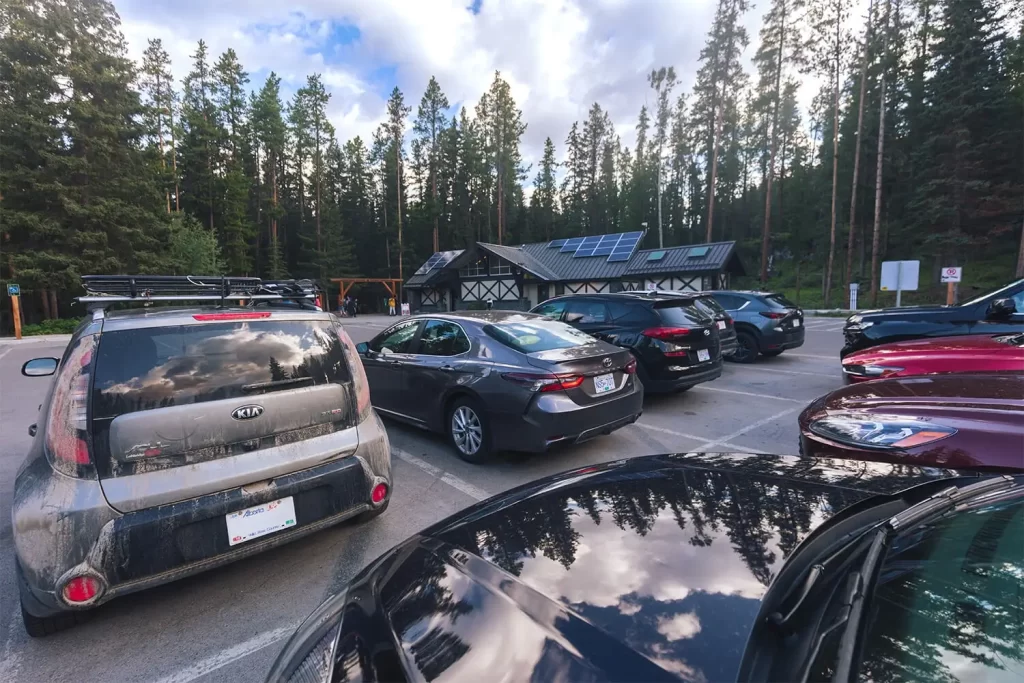
The Johnston Canyon parking lot was busy even early in the morning. Fortunately the busses hadn’t started arriving yet.
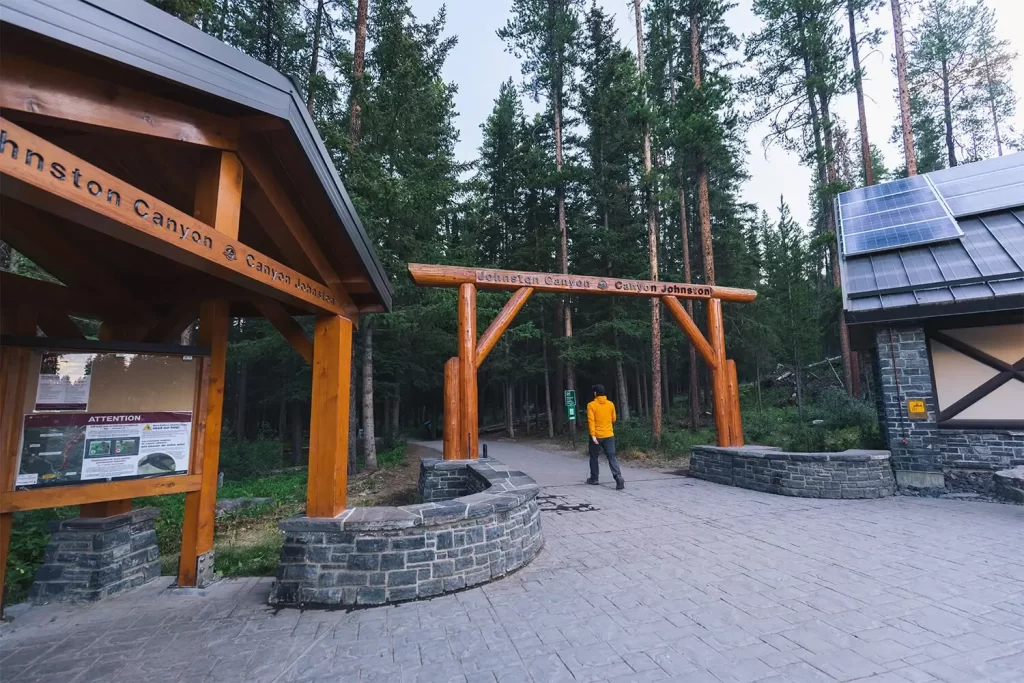
The start of the Johnston Canyon hike. Nice bathroom facilities are available on the right just before the hike starts.
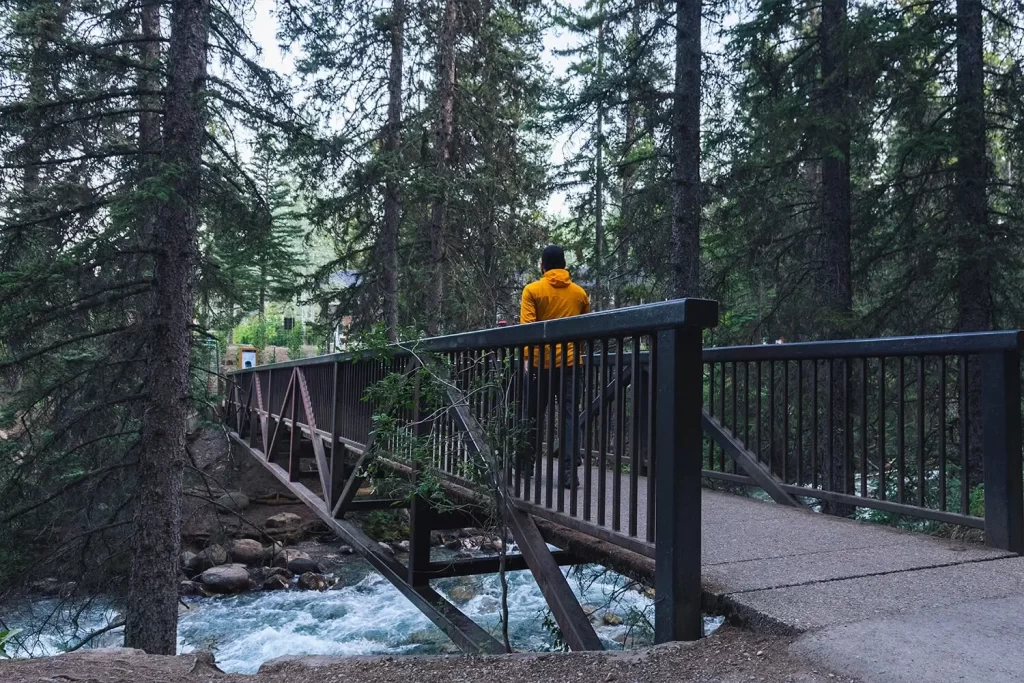
The trail crosses the creek before following it upstream in the other side.
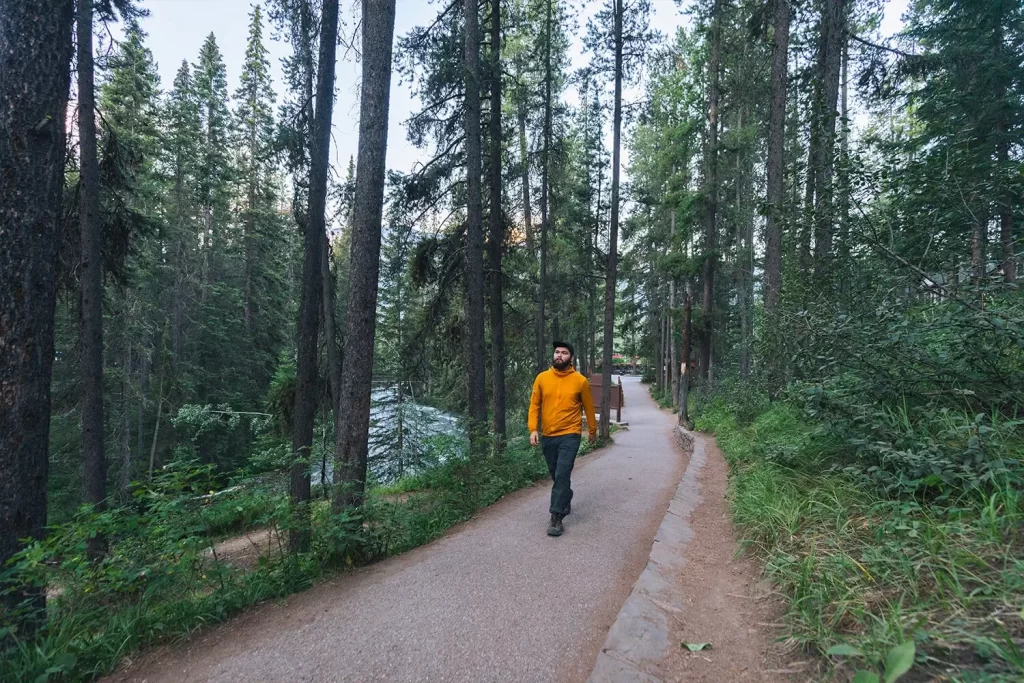
The trail initially leads through the woods and is consistently flat and mild.

As the canyon begins, the trail turns into catwalk suspended along its side.
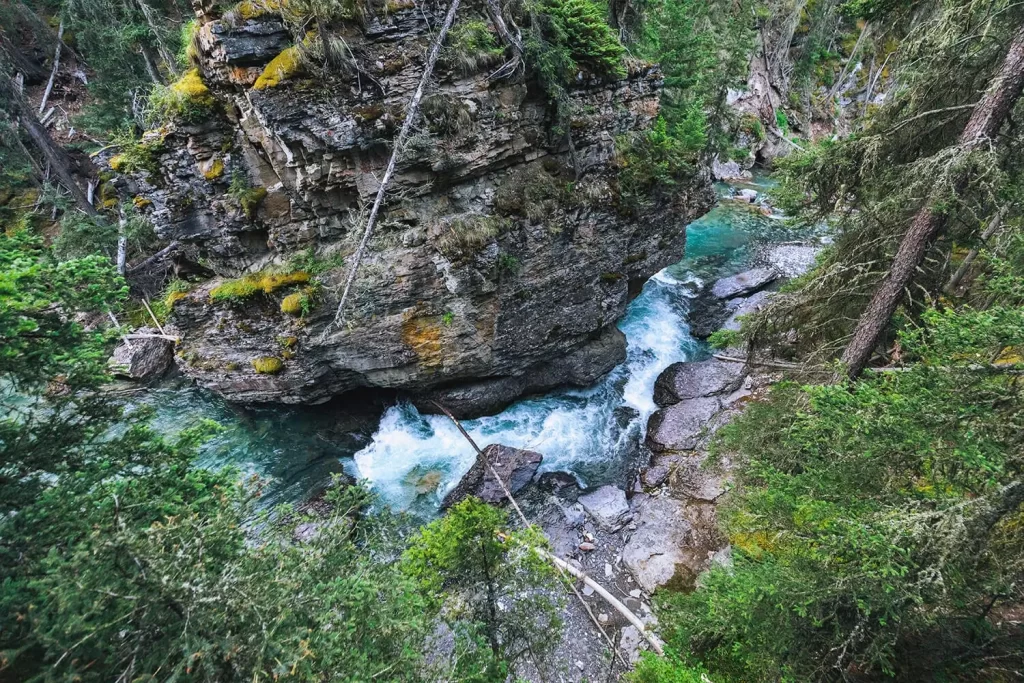
Lovely views of the rushing water below. As tempting as a dip looks, off-trail travel is strictly prohibited. Please avoid trampling vegetation and stay on the trail.
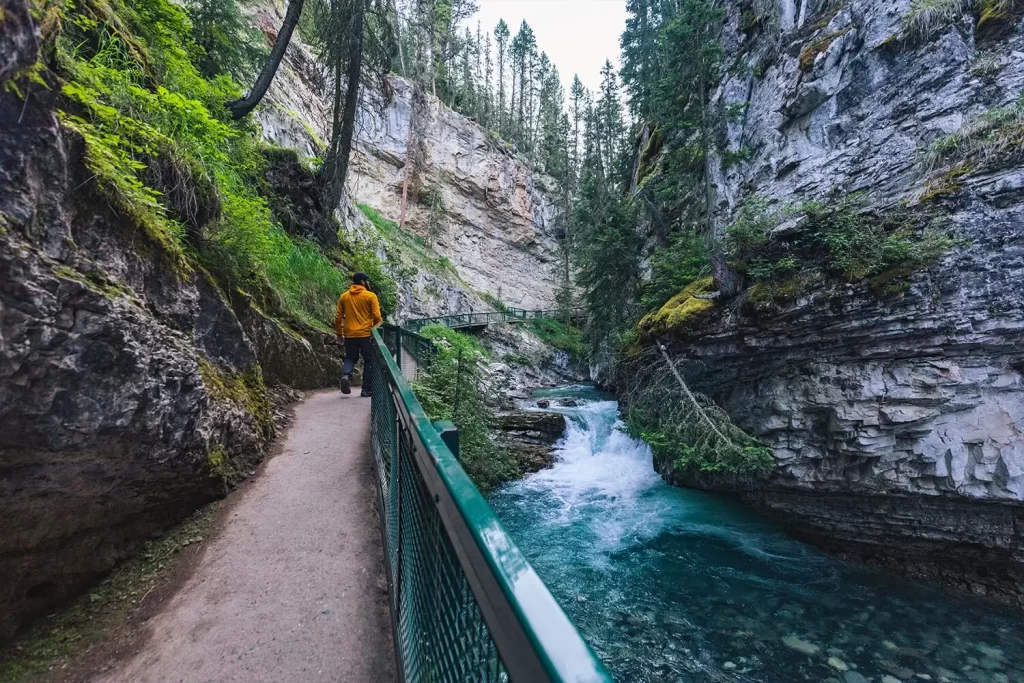
A small waterfall early on.
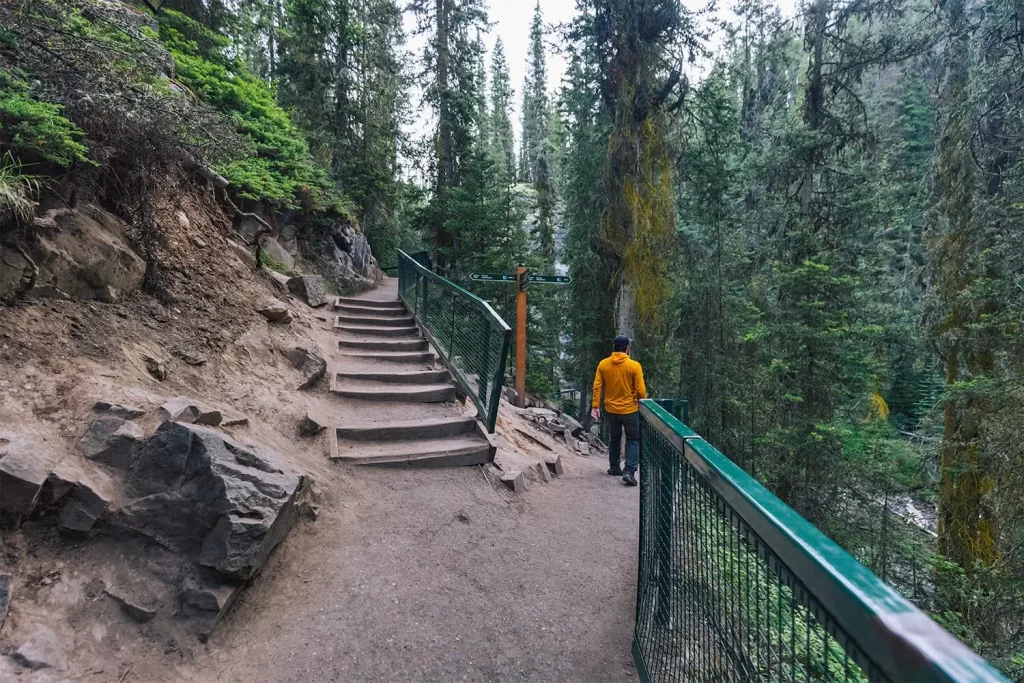
The trail to the left leads on to the upper falls, but first a short diversion down the right trail to the lower falls. Some people choose to only visit the lower falls and turn around, but I highly suggest checking out both, even though the walk to the upper falls takes longer.
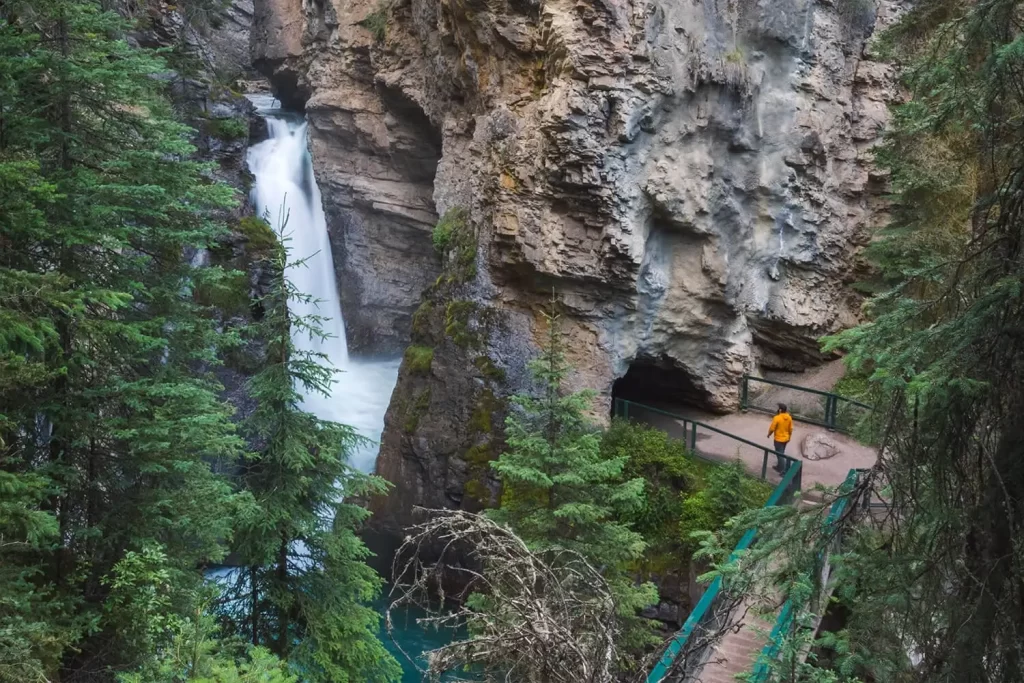
Iconic Lower Falls. In the middle of the day there is a long queue over this bridge leading to the falls.
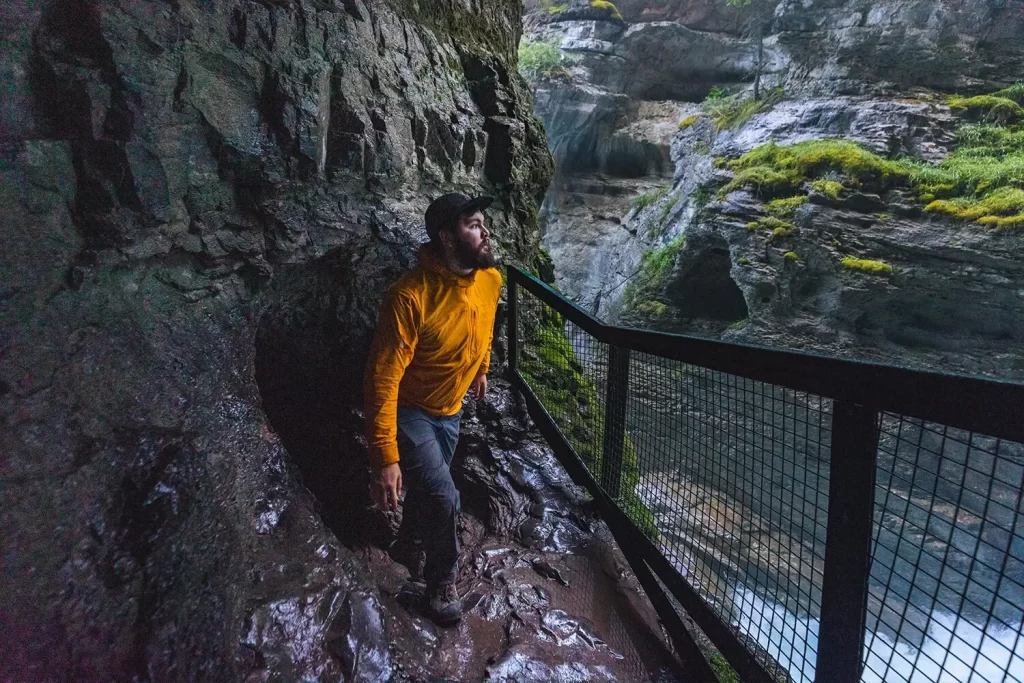
After ducking through the short tunnel, facing a lovely in-your-face view of the waterfall. I’ll leave this view for you to discover yourself 😉

Having gone back to the fork and now ascending up the rest of the way towards the upper falls. Most of the elevation is gained on this section of the trail.
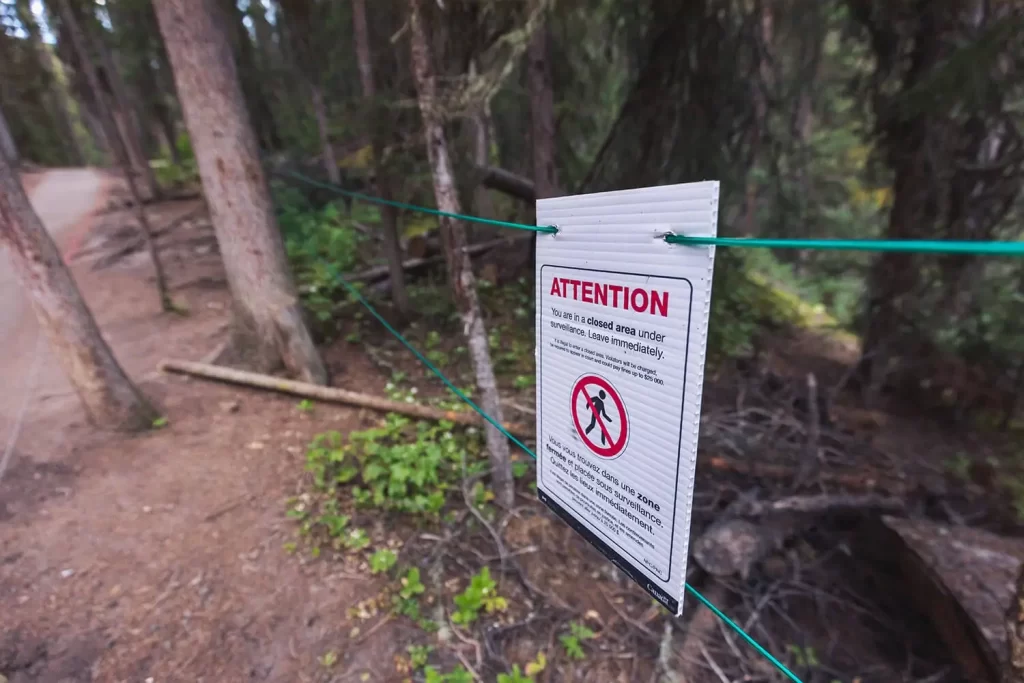
There’s a formerly instagram-viral “secret cave” photo spot off of the main trail in this area, however it is forbidden to visit as it is the rare nesting grounds of endangered Black Swifts. In 2022 further fencing was built here to keep people on the trail as well as cameras installed. Stay on the trail.
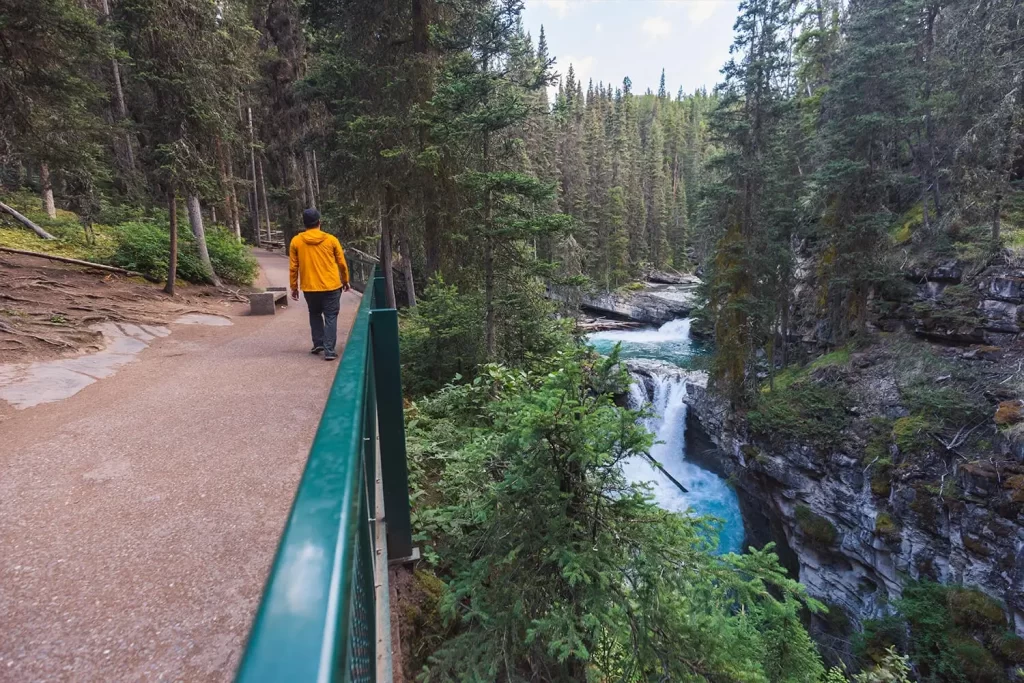
More beautiful waterfall views.
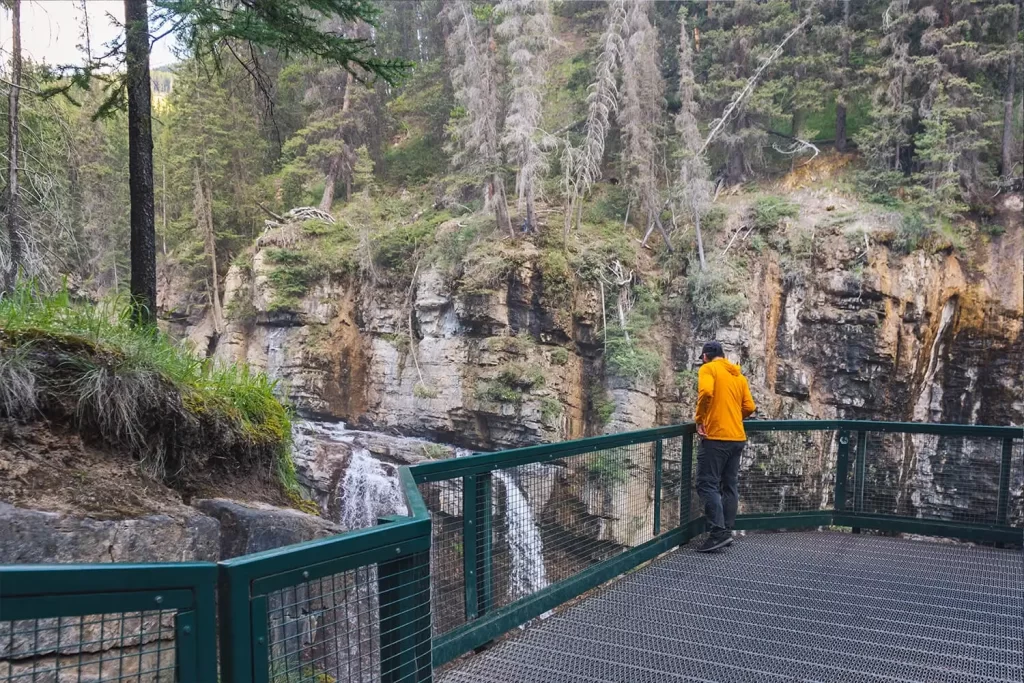
Looking down at the tall upper falls, also seen in the top image of this blog post. This is the most spectacular waterfall in Johnston Canyon, and well worth the walk.
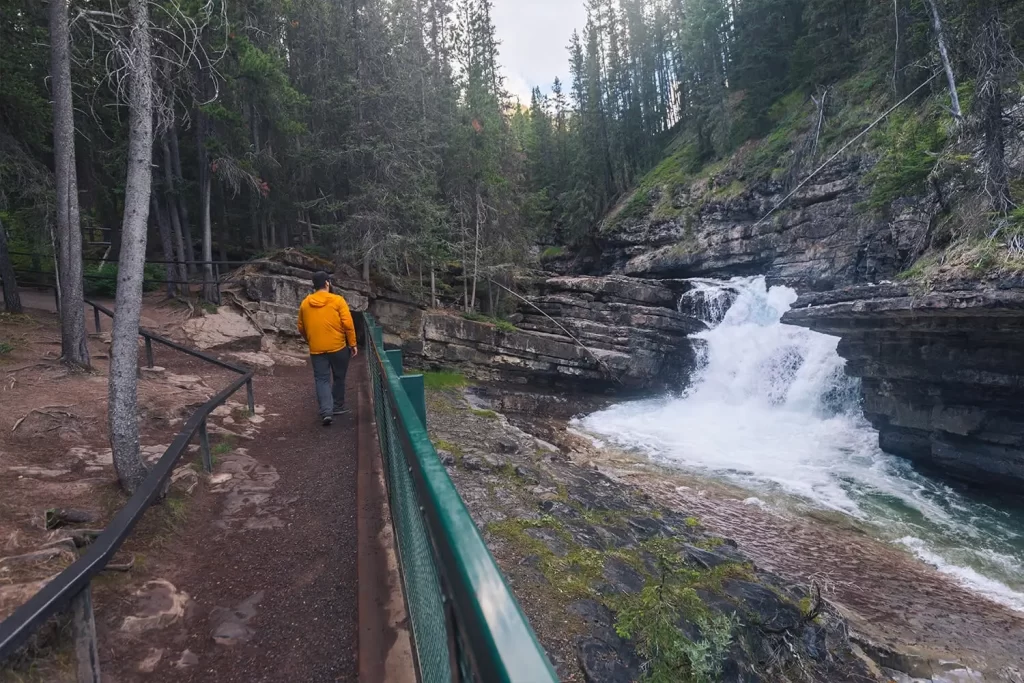
One last waterfall. From here it’s possible to continue following the trail to the ink pots if you’re feeling like further exercise, but the Johnston Canyon hike ends here.
Recommended Hiking Gear



Water is a must whenever I’m hiking, especially if the sun is going to be out. My favourite water filter I’ve used is the Katadyn BeFree 0.6L, which unlike other water filters I’ve used packs up really small and lightweight. For hikes where I know there won’t be any readily available water sources along the way, I make sure to bring my own. The Hydrapak Stow 1L bottle is my go-to, for the same reason that it’s made of a soft plastic that folds up and doesn’t take up any more extra space than necessary in my pack. Finally, Aquatabs are another great option for purifying water, with one tablet being suitable for one litre of water. I previously used the Grayl water filter while travelling internationally, and though I found its hard body more convenient for day to day use and easier to drink from, it has a little too much bulk for my fast-and-light style of hiking.



The secret to all my photos of gorgeous sunset and sunrise mountaintop views? A lot of hiking in the dark. And let me speak from personal experience when I say that the last thing that you want to happen when hiking is to be caught in the dark without a headlamp. I used the Black Diamond Spot 400 for years and it worked great – until I lost it on top of a mountain somewhere. The only downside to it was having to worry about the batteries dying, though there’s also a slightly more expensive version that has a rechargeable battery. Nowadays I’m using the Petzl Actik Core, which is a bit pricier than the more budget-friendly Black Diamond, but is also brighter, more comfortable (in my opinion), and has a hybrid power system that is rechargeable but can also take AAA batteries if needed.
You won’t see me using trekking poles on shorter hikes often – but on long hikes and backpacking trips, as well as certain scrambles, they are an absolute lifesaver. I’ve invested in a high quality ultra-lightweight pair of MSR DynaLock Ascent carbon poles which, while pricey, I don’t regret one bit. If you’re not entirely sure how much use you’re going to get out of a pair of trekking poles, the best budget-friendly option would be the Trekology Trek Z 2.0. Amazon does sell a lot of cheaper Made in China-style trekking poles for cheaper, but these usually are much much heavier and not worth buying.
All the best and most long-lasting cables and power banks I’ve ever owned have been Anker. I once had a phone cable from them that lasted me over three years of daily use! That’s why I keep an Anker PowerCore Essential 20K power bank on me. Like many people I use my phone for a lot of stuff when hiking (checking in with family, using online maps, taking photos, flying my drone) so I like to be prepared for that low battery warning by having a backup power source on me just in case.



The only socks I ever buy for myself are from Darn Tough, and I almost always make sure to wear them when hiking. After years of having no problems only wearing these comfortable and rugged socks for hikes, I accidentally wore a pair of no-name socks on a hike last year and ended up with blisters on both feet. Safe to say I’m back to sticking with the Darn Tough. And the best part? They have a lifetime guarantee, meaning that if they ever wear out you can send them back for a brand new pair. For hiking footwear I go between a pair of lightweight approach shoes for quick and dirty mountain ascents or anything involving scrambling and more heavy-duty boots for longer treks. I’ve worn a couple different versions of the lightweight but super durable Arc’teryx Konseal FL 2 approach shoes for a few years now and am very impressed with the durability. I also really like the thick toecap that keeps me protected every time I stumble into a root or large rock. For longer, tougher, or muddier treks I rely on my LOWA Camino EVO GTX, which I find insanely comfortable and made of very high quality.



I wear my Ar’teryx Gamma Lightweight Pants on every single hike I go on, and on many days when I’m not hiking. After several years of abuse they are still holding together extraordinarily well, with only a few small holes from where I’ve fallen down and some slight stains from being repeatedly coated with mud. They’re lightweight, breathable, and super comfortable. For lightweight and breathable hiking tops I’m a big fan of both the Patagonia Capilene Shirt and the MEC Core Shirt. My Arc’teryx Squamish Hoody shows up in a lot of my photos. It’s super lightweight and packable, and does a great job of cutting the wind while also being pretty breathable. I also have an Arc’teryx Atom Hoody and Arc’teryx Beta LT that I pull out for cooler or wetter conditions.
I hope you enjoyed this guide to hiking Johnston Canyon in Banff National Park! Feel free to leave any questions in the comment section below or to contact me directly via social media.

Hello. We will be hiking this trail the end of September (2024). Do you consider this to be an easy or moderate hike?